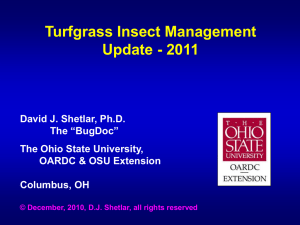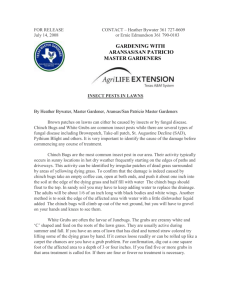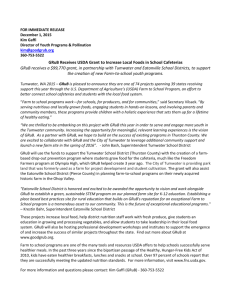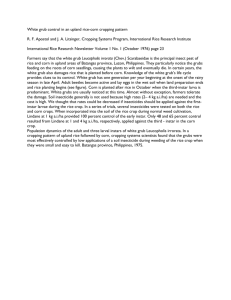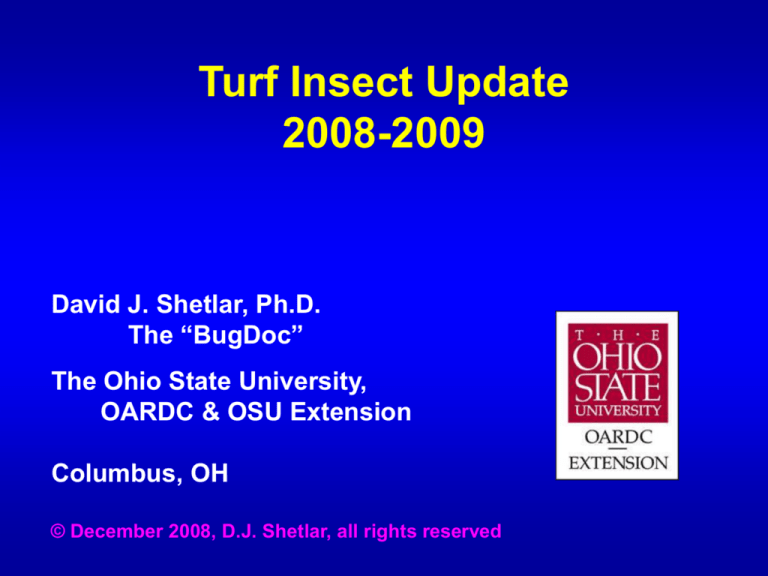
Turf Insect Update
2008-2009
David J. Shetlar, Ph.D.
The “BugDoc”
The Ohio State University,
OARDC & OSU Extension
Columbus, OH
© December 2008, D.J. Shetlar, all rights reserved
http://ohioline.osu.edu
Notes:
The OhioLine is the primary Internet site for OSU
Extension. This site is where all our factsheets and
recent bulletins are posted. Most of these are posted as
web pages and/or downloadable PDF files. Use the
search engine to more rapidly find our publications.
http://buckeyeturf.osu.edu
Notes:
Our BuckeyeTurf web site is where our turfgrass team
posts most of our information on what is going on in all
the fields of turf – sports, golf, lawn, and sod
production. Regular postings are made on the
TurfNotes and SportsNotes pages. We have also posted
quite a few podcasts in several languages that deal with
various turf management issues and pest management.
http://bygl.osu.edu
Notes:
The Buckeye Yard and Garden Line is a weekly posting
of information on what Ohio State horticulture
specialists are seeing across the state. Every Tuesday,
from April through October, specialists have a phone
discussion on what they are seeing and what is
expected over the next week or two. Note takers
summarize this discussion and add pictures, links to
relevant web pages and other information. This is
posted by noon on Thursday.
The P.E.S.T. Newsletter
available from:
Ohio Nursery &
Landscape Association
72 Dorchester Square
Westerville, OH 43081
614-899-1195
800-825-5062
Notes:
I’ll be producing the P.E.S.T. Newsletter again this
season. This newsletter is available by subscription
through the Ohio Nursery and Landscape Association
(onla.org). Every two weeks, from mid-March to midOctober, I present the “BugDoc” view of what is going
on across Ohio in the insect world and I give my often
unique perspectives on management and control. You
can select the option to receive mailed hard copies or
emailed PDF version and all subscriptions provide
passwords to view the newsletter on a web site where
color pictures and links to additional information are
provided.
Come visit the BugDoc at:
http://bugs.osu.edu
Notes:
You can also find information on my personal web site. I
post recent PowerPoint talks in HTML and as downloads
of the actual PowerPoints. There are also links to
BugDoc factsheets, class notes and other goodies. If
you forget how to get to this page, just enter in
“Bugdoc” in Google search and my web page should be
the first on the list!
FQPA Updates
• Food Quality Protection Act (FQPA)
continues to review insecticides and
miticides.
• Pyrethroids review is ongoing! Expect
future restrictions
• Dursban only for farm use (including golf
courses), carbaryl (Sevin) and trichlorfon
(Dylox) passed initial reviews but with
restrictions on amounts! All being
reassessed!
Notes:
Remember that EPA is continuing to review all the
older insecticides under the Food Quality Protection
Act standards. This resulted in most of the
organophosphate and carbamate insecticides being
restricted from urban use. This initial review has been
completed and EPA is currently reviewing all the
pyrethoid insecticides. This will likely result in some
restrictions of these also. While Dursban can still be
used on golf courses with yearly amount restrictions
and Sevin and Dylox are still available for landscape
use, the agency is re-reviewing these pesticides which
may result in further restrictions! Because of this, we
need to look at the newer insecticides that have
passed all the current registration requirements.
New Insecticides
• Acelepryn™ (=E2Y45 or chlorantraniliprole, a
new insecticide category from DuPont) – excellent
grub control, long lasting, etc.; also good on
billbugs, chinch bugs and turf-infesting caterpillars –
Registered in spring of 2008.
• Provaunt™ (Indoxacarb, a new insecticide
category from DuPont) – excellent caterpillar control,
but active against weevil adults.
• Duocide™ (carbaryl plus bifenthrin from The
Andersons) – good grub control with curative action;
also good on turfgrass surface insects.
Notes:
Over the last few years, we have seen several new
insecticides registered for turfgrass insect control.
Acelepryn from DuPont is one of the newest insecticides
and this represents a whole new category of insecticides.
This product is unique in that the label states that no
signal word is needed! We have had excellent grub and
turf caterpillar control and good billbug and chinch bug
control. Provaunt is also in a new insecticide category
and it has great caterpillar control action. We’re also
finding out that it can control some other turfgrass
insects like billbug larvae. Duocide is a low cost general
insecticide that uses a combination of carbaryl (Sevin)
and bifenthrin (like Talstar). This is from the Anderson’s
and can be used to control grubs and a variety of surface
insects.
Other New Insecticides
• Meridian™ (thiamethoxam, a new neonicotinoid
from Syngenta) – excellent grub control, long lasting,
etc. – Registration received in February 2007.
• Aloft™ (=clothianidin plus bifenthrin) – new combo
product from Arysta with excellent broad spectrum
activity and rapid knock-down of surface insects.
Notes:
Meridian (thiamethoxam) is the most recent
neonicotinoid to be registered for turfgrass use. This
product is from Syngenta and has the same broad
spectrum of activity as Merit, but seems to be a bit
faster acting.
Aloft is another combination product (clothianidin plus
bifenthrin) from Arysta. Aloft continues with the broad
spectrum of insect control as Arena (clothianidin by
itself) but surface insect control is achieved more
rapidly.
Turfgrass Insect Activity in 2008
• Bluegrass Billbug – masked by June
rains!
• White Grubs – northern Ohio major
outbreak, middle and southern third
of Ohio patchy or AWOL!
• Cutworms & Sod Webworms – up!
• Hairy Chinch Bug – continues to be
missed!.
Notes:
The 2008 season was characterized by being normal or
slightly above normal in rainfall through mid-June.
Then the rains stopped for most of the rest of June and
in the southern half of Ohio rain was scarce until the
end of September. In the northern third of Ohio, there
was sufficient rain in July through September to raise a
pretty good grub crop! Due to adequate soil moistures
in June, billbug damage was minimal. Grub damage
was most noticeable in the northern third of the state.
And, as normal, cutworm and sod webworm populations
were generally up as they always seem to do better in
drought situations. Finally, chinch bugs continued to be
misdiagnosed in lawns across Ohio.
Ohio Lawn Damaged (killed) by Bluegrass Billbug!
Notes:
This central Ohio lawn was essentially killed by billbug
larvae by the end of June! Notice the surrounding
lawns are in good shape because they were treated in
May. The green clumps of grass surviving in this lawn
were perennial ryegrass clumps. Perennial ryegrass
containing fungal endophytes are toxic to billbug adults
and larvae so this type of grass makes it a good choice
for keeping billbugs, chinch bugs and sod webworm
populations down.
Billbug Diagnosis – Use the “tug test”
Notes:
Billbug activity and damage is easy to diagnose by midJune. Simply grasp dead stems and pull upward.
Inspect the broken ends of the stems for evidence of
fine sawdust-like material. This is the frass or fecal
material left behind by billbug larvae as they burrow
down grass stems. This damage and frass remains in a
lawn well into October and can be used as a diagnostic
technique if a lawn doesn’t green up in the fall.
2006 Ohio Billbug Test
Treatment
Rate
% Control
Merit 0.5G
0.187
64
Merit 0.5G
0.25
73
Merit 75WDG
0.30
95
Arena 50WDG
0.20
100
Meridian 25W
0.25
91
Sevin Lawn 2G
7.80
73
Triazicide 0.114G
0.50
59
appl - 24 May (early curative); Columbus, OH;
read – 12 July; 31.9 larvae+pupae/sq.ft. check
Notes:
The neonicotinoids, imidacloprid (Merit), clothianidin
(Arena & Aloft), and thiamethoxam (Meridian) are good
choices for control of billbugs in Ohio. Make the
application in the last two weeks of May and the soilthatch residue will also control white grubs that
typically arrive in July.
2007 Ohio Billbug Then Grub Test
Treatment
Rate
Billbug
% Control
Grub
% Control
Aloft SC
0.12/0.06 lb.
100.0
68.0
Aloft SC
0.24/0.12 lb.
95.5
100.0
Aloft G
0.25/0.13 lb.
77.3
100.0
68.2
80.0
Bifenthrin SC
24oz/A
Meridian 25WDG
0.20
100.0
84.0
Merit 75 WP
0.25
77.3
72.0
Arena 50WDG
0.25
100.0
100.0
appl - 9 May; Columbus, OH; billbug read – 28 June, 18.6/sq.ft. check;
JB adults caged in July, grubs read - 28 Sept, 17.9/sq.ft. checks
Notes:
To illustrate the lasting efficacy of the neonicotinoids for
billbug plus white grub control, this study was put out in
a turfgrass stand known to be infested with billbugs.
After the billbug rating, Japanese beetle adults were
caged over the treated suraces and forced to lay eggs.
You can see how well the grubs were controlled by the
neonicotinoids, Aloft, Meridian, Merit and Arena.
Grub Complex –
Changing each year!
Ataenius
Aphodius
May/June Beetle
green June beetle
European chafer
masked chafer
Japanese beetle
Oriental beetle
Asiatic garden beetle
Notes:
Ohio has the dubious honor of being infested by most
of the common cool-season grub species! While
Japanese beetles and masked chafers are our dominant
species, we have green June beetles from Dayton to
Cincinnati and over to Portsmouth as well as Oriental
beetles, European chafers and Asiatic garden beetles in
the counties surrounding Lake Erie. It’s always good to
check and see which species you are dealing with
because some of the grubs can be more difficult to
control unless you use maximum rates of insecticides.
Notes:
This image of a heavy grub infestation is put here to
remind me that occasionally we get grub populations
that will exceed 50 per square foot! Under such
situations, even if you get 90% control, there may be
enough survivors that the skunks and raccoons may
continue to dig up the turf. This is not really a grub
insecticide failure, but the result of excessive grub egg
laying and survival. In such cases, if the thatch is not
over ½-inch thick, consider making a second application
of a rapid acting insecticide (like Dylox, Arena or
Meridian) and/or spread Milorganite over the area to
discourage the animal digging.
Ranked Efficacy of White Grub Insecticides
1976 – 2008a
Insecticide
Carbaryl
(=Sevin)
rate
ave
range
lb.ai./a. % control # tests % control
8.0
72.8
43
13-100
% of tests
below 70%
40
Cl-antraniliprole 0.1
(=Acelepryn)
0.2
93.9
98.9
11
7
70-100
89-100
0
0
Clothianidin
(=Arena)
0.25
0.3
97.2
99.4
5
5
90-100
99-100
0
0
Halofenozide
(=MACH2)
1.5
2.0
91.2
89.6
65
55
10-100
56-100
12
9
Imidacloprid
(=Merit)
0.3
0.4
96.4
94.1
103
7
58-100
82-100
5
0
Permethrin
0.26
31.8
8
0-54
100
Thiamethoxam
(=Meridian)
0.2
95.1
53
0-100
5
Trichlorfon
8.0
(=Dylox, Proxol)
77.2
92
0-98
19
a
Data from ESA publications (1977-2008) & Ohio testing using masked chafer and Japanese beetle data where
label timing recommendations were used and at least 4.0 grubs per sq.ft. were found in checks.
Notes:
This summary table contains averages of many field
studies performed across North America where
insecticides were used to kill masked chafer and/or
Japanese beetle grubs. Applications made in June,
July and early August were included. Study the results
carefully and you will see that most of our standard
grub control products work well when applied during
this period. Notice that permethrin (the active
ingredient in the over-the-counter Triazicide product) is
NOT a good grub control material!
Japanese Beetle Annual Cycle
JAN FEB MAR APR MAY JUN JUL AUG SEP OCT NOV DEC
Preventive-Early Curative Timing
Traditional Control Timing
Notes:
In the past, we have stated that the best time to apply a
grub control product is mid-July into mid-August, but
the new neonicotinoids (imidacloprid, clothianidin, and
thiamethoxam) and Acelepryn are known to have
effective residues remaining in the soil-thatch interface
for 90+ days. If we factor in this, we can also control
billbugs and chinch bugs through mid-May into early
June applications. Acelepryn, when applied in midMay also will control caterpillar pests for several
months.
Comparison of Grub Insecticide Efficacy
by Time of Application
Insecticide
Clothianidin
(=Arena)
rate
lb.ai./a.
to Sept 10
99.9 (5)
93.0 (1)
90.0 (1)
99.6 (3)
98.8 (5)
99.0 (2)
-----
83.4 (2)
97.0 (1)
Cl-antraniliprole
0.1
(=Acelepryn) 0.2
92.8 (4)
94.8 (4)
93.3 (9)
99.8 (4)
91.6 (2)
98.2 (5)
-----
-----
Halofenozide
(=MACH2)
1.5
2.0
88.5 (8)
80.5 (4)
94.4 (23) 88.8 (21) 89.6 (19)
63.7 (9) 94.3 (13) 75.9 (6)
77.7 (27)
---
Imidachloprid
(=Merit)
0.3
0.4
80.7 (22) 93.3 (42) 95.2 (48) 93.8 (30)
81.0 (2) 94.0 (2) 96.8 (5) 82.0 (1)
93.2 (37)
---
Thiamethoxam
(=Meridian)
0.2
0.26
59.9 (8)
83.5 (5)
85.2 (12)
89.7 (6)
Trichlorfon
8.0
a
0.25
0.3
May
ave % control (#tests)
June
July
to Aug 16
---
96.7 (13) 95.6 (25) 92.9 (15)
99.3 (3) 99.8 (5) 94.6 (9)
---
38.5 (1) 62.2 (5)
77.2 (25)
Data from ESA publications (1977-2008) & Ohio testing using masked chafer and Japanese beetle data where
label timing recommendations were used and at least 4.0 grubs per sq.ft. were found in checks.
Notes:
In the past, we didn’t have much data on applications
of grub insecticides made in May or late August into
early September, periods before and after the socalled “ideal” grub window. This table contains
averages of studies that have been done in these
various windows. You can see that most of the grub
insecticides maintain good control when applied in
May or from mid-August into early September.
2006 May Preventive Grub Trial (15 May)
Treatment
Rate
% Control
Acelepryn SC
0.26 lb.
100
Acelepryn SC
0.21 lb.
100
Acelepryn SC
0.10 lb.
100
Acelepryn SC
0.05 lb.
99
Arena 50WDG
0.25 lb.
100
Arena 50WDG
0.15 lb.
99
Merit 75WP
0.30 lb.
99
MACH2 1.5G
2.00 lb.
56
Hilliard, OH; read - 11 Oct; 25.3 grubs/ft.sq. check; 74%NMC/26%JB
Notes:
This is a summary of the results obtained using
Acelepryn compared to Arena and Merit (standard
neonicotinoids) and MACH2 (an insect growth regulator)
following a May 15 application. It’s obvious that all
products except for the MACH2 performed very well.
2007 Grub Trial - Rate & Timing
Treatment
Rate
Appl.Date
Aloft SC
Aloft SC
Aloft G
Merit 75WP
Aloft SC
Aloft SC
Aloft G
Merit 75WP
Aloft SC
Aloft SC
Aloft G
0.12/0.06 lb.
0.24/0.12 lb.
0.25/0.13 lb.
0.30 lb.
0.12/0.06 lb.
0.24/0.12 lb.
0.25/0.13 lb.
0.30 lb.
0.12/0.06 lb.
0.24/0.12 lb.
0.25/0.13 lb.
17Apr
17Apr
17Apr
17Apr
26June
26June
26June
26June
6Sept
6Sept
6Sept
DAT
168
168
168
168
98
98
98
98
26
26
26
% Control
78
100
100
84
100
100
100
95
95
95
97
Columbus, OH; read - 2 Oct; 4.63 grubs/ft.sq. check; 27%NMC/73%JB
Notes:
This table shows the results from making applications
of Aloft (the combination of clothianidin plus bifenthrin)
compared to Merit when applied in mid-April, June and
September.
Use Milorganite™ to discourage animals!
Notes:
As stated before, skunks and raccoons can be more of a
problem than the grubs! Only 3 to 5 grubs per square
foot may be sufficient to encourage animal digging and
this number of grubs rarely damages the turf. To
discourage skunk or raccoon digging, especially after a
rescue grub treatment, consider spreading the organic
fertilizer Milorganite over the area. This fertilizer is
made with human sewage sludge and is pretty good is
discouraging these animals.
Notes:
The hairy chinch bug continues to be a problems
across Ohio, primarily in sodded Kentucky bluegrass
lawns. The damage is often mistaken for disease or
drought damage so close inspection is needed to
determine the actual cause of straw-colored turf.
Hairy chinch bugs in thatch
Hairy chinch bug adults long wing & short wing forms
Notes:
Chinch bugs are relatively easy to diagnose! Simply
spread apart the turf canopy where straw-colored turf
meets green turf. If chinch bugs are present, they will
be seen running around in the thatch zone. The adult
chinch bugs also occasionally walk to the tips of grass
blades where they can also be observed.
2005 OH Hairy Chinch Bug Control –
Over-the-Counter Insecticides
% Control
4DAT
7DAT 14DAT
Treatment
Rate
Merit 0.2G
0.13
77
70
93
Merit 0.2G
0.10
28
81
95
Arena 0.1G
0.06
51
86
75
Arena 0.1G
0.05
82
75
64
Triazicide 0.04G
0.034
62
93
92
Grub Stop 1.5G
1.01
38
82
86
Bayer Complete
0.19
64
80
88
appl. 21 July., Pickerington, OH; 70.6, 111.8 & 116.4 hcb/sq.ft. checks @ 4, 7 & 14 DAT
Notes:
While the pyrethoid, bifenthrin (Talstar) has been the
industry standard for chinch bug control, the
neonicotinoids (Merit, Arena and Meridian) can also
control chinch bugs, but these often take 7 to 14 days
to achieve maximum control. Other pyrethroids also
do a very good job. Consider lambda-cyhalothrin
(Scimitar), deltamethrin (DeltaGard), and betacyfluthrin (Tempo Ultra) as alternate pyrethroids.

